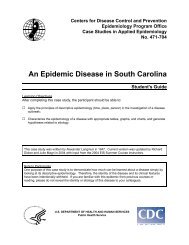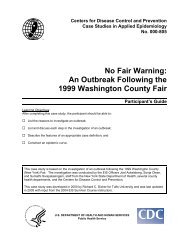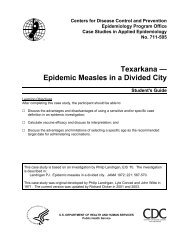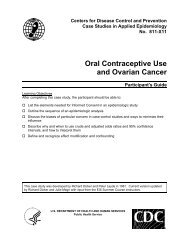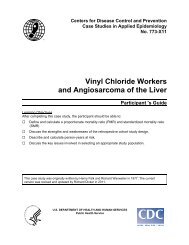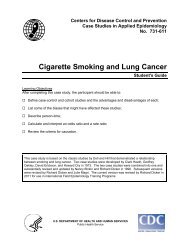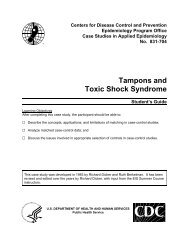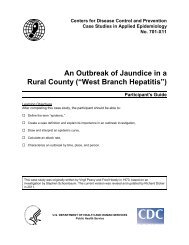An Outbreak of Streptococcal Pharyngitis in Louisiana - Library
An Outbreak of Streptococcal Pharyngitis in Louisiana - Library
An Outbreak of Streptococcal Pharyngitis in Louisiana - Library
Create successful ePaper yourself
Turn your PDF publications into a flip-book with our unique Google optimized e-Paper software.
CDC / EIS: <strong>Pharyngitis</strong> <strong>in</strong> <strong>Louisiana</strong> (942-211) - Participant's Guide page 2PART IOn May 16, 1991, a teacher at a privateelementary school <strong>in</strong> <strong>Louisiana</strong> called theEpidemiology Section <strong>of</strong> the <strong>Louisiana</strong>Department <strong>of</strong> Public Health and Hospitals(LDHH) to report that a number <strong>of</strong> students andmembers <strong>of</strong> their families had become ill withsore throat and/or cervical lymph node swell<strong>in</strong>g(“swollen glands”). A few had been seen by theirprivate physicians and had been diagnosed ashav<strong>in</strong>g streptococcal pharyngitis, or “strepthroat.”Question 1:What questions might you ask dur<strong>in</strong>g the telephone conversation with the teacher?While the LDHH epidemiologist was on thetelephone with the teacher, she reached for hercopy <strong>of</strong> Control <strong>of</strong> Communicable DiseasesManual to review the basic cl<strong>in</strong>ical andepidemiologic aspects <strong>of</strong> streptococcalpharyngitis.Question 2:List at least two on-l<strong>in</strong>e sources <strong>of</strong> <strong>in</strong>formation about the basic cl<strong>in</strong>ical and epidemiologicaspects <strong>of</strong> streptococcal pharyngitis. Does your assigned state have a fact sheet?
CDC / EIS: <strong>Pharyngitis</strong> <strong>in</strong> <strong>Louisiana</strong> (942-211) - Participant's Guide page 3The private school had an enrollment <strong>of</strong> 355children <strong>in</strong> k<strong>in</strong>dergarten through 8th grade. OnMay 11, 1991, the school held a banquet at alocal country club to honor students <strong>in</strong> the 5ththrough 8th grades who had participated <strong>in</strong> thesports program. Approximately 200 persons,<strong>in</strong>clud<strong>in</strong>g students, teachers, and familymembers, attended the banquet.By May 16, twenty students and four familymembers, who had attended the banquet wereknown to have become ill. All ill personsreported hav<strong>in</strong>g sore throat. Eighteen reportedhav<strong>in</strong>g cervical lymphadenopathy (“swollenglands”) and 16 reported hav<strong>in</strong>g fever. Four <strong>of</strong>these persons had a positive throat culture orrapid antigen detection test for group Astreptococci.Based on school absentee records, about 1-2students normally miss school each week due tostreptococcal pharyngitis or similar illnesses.The number tends to <strong>in</strong>crease <strong>in</strong> late w<strong>in</strong>ter andearly spr<strong>in</strong>g.Question 3:Do you th<strong>in</strong>k these cases represent an outbreak? Why?LDHH decided to conduct an <strong>in</strong>vestigation. Two epidemiologists were dispatched to the school to <strong>in</strong>itiatethe <strong>in</strong>vestigation.Question 4:List the steps <strong>of</strong> an outbreak <strong>in</strong>vestigation.
CDC / EIS: <strong>Pharyngitis</strong> <strong>in</strong> <strong>Louisiana</strong> (942-211) - Participant's Guide page 4Persons with streptococcal pharyngitis frequentlyexhibit fever, sore throat, exudative tonsillitis orpharyngitis, and tender anterior cervical lymphnodes. Laboratory f<strong>in</strong>d<strong>in</strong>gs which support GroupA streptococcal disease <strong>in</strong>clude identification <strong>of</strong>group A streptococcal antigen <strong>in</strong> pharyngealsecretions (i.e., the rapid strep test) or isolation<strong>of</strong> organisms from the affected tissues on bloodagar or other appropriate media.Question 5: How would you def<strong>in</strong>e a case <strong>of</strong> group A streptococcal pharyngitis for the <strong>in</strong>vestigation?When might you want a relatively loose versus a relatively strict case def<strong>in</strong>ition?
CDC / EIS: <strong>Pharyngitis</strong> <strong>in</strong> <strong>Louisiana</strong> (942-211) - Participant's Guide page 5PART IIEpidemiologists from LDHH conducted a survey<strong>of</strong> the families <strong>of</strong> all children <strong>in</strong> the 5th-8thgrades. Students were given questionnairesand were asked to have their parents completethem with <strong>in</strong>formation on all householdmembers.Question 6:What <strong>in</strong>formation would you <strong>in</strong>clude <strong>in</strong> the questionnaire?One hundred (82%) <strong>of</strong> the 122 households <strong>of</strong>children attend<strong>in</strong>g 5th-8th grades returned thequestionnaire. Data from these questionnaireswere entered <strong>in</strong>to an EPI INFO data file namedschool2.names (<strong>in</strong> italics) used <strong>in</strong> school2. Personsmeet<strong>in</strong>g the case def<strong>in</strong>ition are <strong>in</strong>dicated <strong>in</strong> thevariable CASE. Appendix 2 provides a briefreview <strong>of</strong> EPI INFO ANALYSIS commands.To answer Questions 7, 8, 10, and 11, use EPIINFO ANALYSIS to access the xpharyngitis.mdbfile, then access the school2 view. Appendix 1<strong>in</strong>cludes a copy <strong>of</strong> the questionnaire and variable
CDC / EIS: <strong>Pharyngitis</strong> <strong>in</strong> <strong>Louisiana</strong> (942-211) - Participant's Guide page 6Question 7:Us<strong>in</strong>g Epi Info and the school2 data <strong>in</strong> the xpharyngitis.mdb file, generate the descriptiveepidemiology <strong>of</strong> “person” for this outbreak.(Suggestion: After read<strong>in</strong>g file, click on the Set command. Be sure that “IncludeMiss<strong>in</strong>g” and “Show Percents” are clicked on; set “Statistics” to “M<strong>in</strong>imal”.)At the very least,a. Review for yourself the variables <strong>in</strong>cluded <strong>in</strong> the data setb. How many households are <strong>in</strong>cluded <strong>in</strong> the data set? How many households had atleast one case? Did any households have more than one case?c. Calculate the overall attack rate.d. Calculate attack rates by 5-year age group.e. Calculate attack rates by sex.f. Calculate attack rates by grade.
CDC / EIS: <strong>Pharyngitis</strong> <strong>in</strong> <strong>Louisiana</strong> (942-211) - Participant's Guide page 7Question 8:Us<strong>in</strong>g Epi Info and the school2 data <strong>in</strong> the xpharyngitis.mdb file, describe the cl<strong>in</strong>icalfeatures <strong>of</strong> the cases <strong>in</strong> this outbreak.Question 9:What is the value <strong>of</strong> an epidemic curve?
CDC / EIS: <strong>Pharyngitis</strong> <strong>in</strong> <strong>Louisiana</strong> (942-211) - Participant's Guide page 8Question 10a: Draw an epidemic curve for this outbreak (either computer-generated or hand-drawnon graph paper is acceptable). Be sure it <strong>in</strong>cludes an appropriate title and axis labels.Mark the date <strong>of</strong> the banquet on the epidemic curve.Question 10b: What proportion <strong>of</strong> cases had onset <strong>of</strong> symptoms 1–3 days after the banquet?Question 10c: Describe and <strong>in</strong>terpret your epidemic curve.
CDC / EIS: <strong>Pharyngitis</strong> <strong>in</strong> <strong>Louisiana</strong> (942-211) - Participant's Guide page 9At this po<strong>in</strong>t, one <strong>of</strong> the two LDHHepidemiologists felt that there was sufficientevidence to associate the outbreak with theschool banquet. The other epidemiologistdisagreed.Question 11: Us<strong>in</strong>g Epi Info and the school2 data <strong>in</strong> the xpharyngitis.mdb file, evaluate the hypothesisthat attendance at the banquet was associated with strep pharyngitis. (Suggestion: SetStatistics to Intermediate.)
CDC / EIS: <strong>Pharyngitis</strong> <strong>in</strong> <strong>Louisiana</strong> (942-211) - Participant's Guide page 10PART IIIThe banquet consisted <strong>of</strong> a buffet meal cateredby the local country club. The menu <strong>in</strong>cluded agreen salad, baked chicken, macaroni-andcheese,green beans, rolls, beverages, andpeach cobbler. Six foodhandlers were <strong>in</strong>volved<strong>in</strong> prepar<strong>in</strong>g the food. Foodhandlers A, B, and Cprepared the salad, rolls, and dessert.Foodhandlers E and F prepared the bakedchicken and the green beans. Foodhandler Dprepared the macaroni-and-cheese and helpedprepare the green beans. Five country clubemployees served the food to attendees from thebuffet table between 7 P.M. and 9 P.M.People were seated at the banquet accord<strong>in</strong>g topersonal choice. The diagram below showswhere persons who became ill sat dur<strong>in</strong>g thebanquet.Seat<strong>in</strong>g Location <strong>of</strong> Cases
CDC / EIS: <strong>Pharyngitis</strong> <strong>in</strong> <strong>Louisiana</strong> (942-211) - Participant's Guide page 11Question 12: Review the modes <strong>of</strong> transmission for a communicable disease. What are the modes <strong>of</strong>transmission <strong>of</strong> group A streptococcal pharyngitis? Does person-to-person spread seemlikely <strong>in</strong> this outbreak? Why or why not?To <strong>in</strong>vestigate the source <strong>of</strong> <strong>in</strong>fection at thebanquet, only persons attend<strong>in</strong>g the banquetwere <strong>in</strong>cluded <strong>in</strong> the analyses. The casedef<strong>in</strong>ition was modified to <strong>in</strong>clude only studentsand family members who attended the banquetand who had onset <strong>of</strong> illness from 1–3 days afterthe banquet.Food histories among persons attend<strong>in</strong>g thebanquet are provided <strong>in</strong> EPI INFO (banquet).Appendix 1 <strong>in</strong>cludes variable names used <strong>in</strong>banquet. Persons meet<strong>in</strong>g the revised casedef<strong>in</strong>ition are <strong>in</strong>dicated <strong>in</strong> the variable CASE.Question 13a: What type <strong>of</strong> study is this?Question 13b: What is the appropriate measure <strong>of</strong> association for this type <strong>of</strong> study?
CDC / EIS: <strong>Pharyngitis</strong> <strong>in</strong> <strong>Louisiana</strong> (942-211) - Participant's Guide page 12Question 14: Calculate attack rates, the appropriate measure <strong>of</strong> association, and 95% confidence<strong>in</strong>tervals for each food item served at the banquet, and complete the follow<strong>in</strong>g grid.(Suggestion: In Epi Info, set “Include Miss<strong>in</strong>g” to OFF; set “Statistics” to “Intermediate.”)Food itemSaladBaked chickenMacaroni-and-cheeseGreen beansRollsCobblerTeaDr<strong>in</strong>ksC<strong>of</strong>feeIllATE FOOD DID NOT EAT FOOD Measure <strong>of</strong>AttackAttack AssociationTotal Rate Ill Total Rate (and 95% CI)CreamQuestion 15: Which food item(s), if any, is/are most suspect as the source? If two foods aresuspected, determ<strong>in</strong>e the <strong>in</strong>dependent effect <strong>of</strong> each.
CDC / EIS: <strong>Pharyngitis</strong> <strong>in</strong> <strong>Louisiana</strong> (942-211) - Participant's Guide page 13Question 16: How might this (these) food item(s) have become contam<strong>in</strong>ated?Question 17: Outl<strong>in</strong>e further <strong>in</strong>vestigations or actions that should be undertaken.
CDC / EIS: <strong>Pharyngitis</strong> <strong>in</strong> <strong>Louisiana</strong> (942-211) - Participant's Guide page 14PART IVThroat cultures were obta<strong>in</strong>ed from 24 studentswho attended the banquet and 15 who did not.Five (21%) <strong>of</strong> those who attended the banquetand none <strong>of</strong> those who did not had positivecultures for group A streptococci. Throatcultures from the six foodhandlers and fiveservers were negative. However, group Astreptococci was cultured from a lesion on thehand <strong>of</strong> Foodhandler D. All six group Astreptococci isolates (and an additional isolateprovided by a parent who had attended thebanquet) were found to be T-agglut<strong>in</strong>ation type5/9, and either M-type 9 or OF-type 9.Foodhandler D reported that he obta<strong>in</strong>ed thelesion <strong>in</strong> a barroom fight two weeks before thebanquet. He treated the lesion with a topicalo<strong>in</strong>tment and covered it with a gauze bandage.The wound swelled for two days but thenimproved. The wound was covered with gauzewhile Foodhandler D prepared the macaroniand-cheese.The macaroni-and-cheese was prepared the daybefore the banquet. At 4 P.M., Foodhandler Dwarmed one gallon <strong>of</strong> milk and one gallon <strong>of</strong>cream on a stove. This mixture was thencomb<strong>in</strong>ed with cheese, corn starch, salt, pepper,and cooked macaroni noodles. The mixture wasplaced <strong>in</strong>to five large "hotel pans" and stored <strong>in</strong> awalk-<strong>in</strong> refrigerator at 7 P.M. The next day, at 6P.M., Foodhandler D took the pans out <strong>of</strong> therefrigerator and warmed them at 250ºF for 45m<strong>in</strong>utes. He then stored the pans under heatlamps for one to two hours until they wereserved between 7 and 9 P.M. Foodhandler Dagreed that throughout the preparation, the dishwas never fully cooked.Laboratory studies undertaken by Dr. Ed Kaplanat the University <strong>of</strong> M<strong>in</strong>nesota suggest that groupA streptococci can survive and even multiply <strong>in</strong>macaroni-and-cheese made accord<strong>in</strong>g to theabove recipe as well as <strong>in</strong> a popular commercialbrand.Question 18: With whom would you share the results <strong>of</strong> the <strong>in</strong>vestigation?
CDC / EIS: <strong>Pharyngitis</strong> <strong>in</strong> <strong>Louisiana</strong> (942-211) - Participant's Guide page 15Question 19: Refer to the follow<strong>in</strong>g steps <strong>of</strong> an outbreak <strong>in</strong>vestigation. How well did this <strong>in</strong>vestigationconform to the list?1. Identify potential <strong>in</strong>vestigation team and resources / Prepare for field work (e.g.,adm<strong>in</strong>istration, clearance, travel, contacts, designation <strong>of</strong> lead <strong>in</strong>vestigator, etc.)2. Establish the existence <strong>of</strong> an outbreak / epidemic3. Verify the diagnosis4. Construct a work<strong>in</strong>g case def<strong>in</strong>ition5. F<strong>in</strong>d cases systematically, develop l<strong>in</strong>e list<strong>in</strong>g6. Perform descriptive epidemiology7. Develop hypotheses8. Evaluate hypotheses9. As necessary, reconsider / ref<strong>in</strong>e hypotheses and execute additional studiesa. Additional epidemiologic studiesb. Other types <strong>of</strong> studies (e.g., laboratory, environmental)10. Implement control and prevention measures (as early as possible)11. Communicate f<strong>in</strong>d<strong>in</strong>gs Summarize <strong>in</strong>vestigation for request<strong>in</strong>g authority Prepare written report(s)12. Ma<strong>in</strong>ta<strong>in</strong> surveillance to monitor trends and evaluate control / prevention measuresFURTHER READING<strong>Streptococcal</strong> PhyarngitisFarley TA, Wilson SA, Mahoney F, Kelso KY, Johnson DR, Kaplan EL. Direct <strong>in</strong>oculation <strong>of</strong> food asthe cause <strong>of</strong> an outbreak <strong>of</strong> group A streptococcal pharyngitis. J Infect Dis 1993;167:1232-1235.Heymann D, ed. Control <strong>of</strong> Communicable Diseases Manual, 19 th ed. Wash<strong>in</strong>gton, DC: AmericanPublic Health Association, 2008.http://wiki.medpedia.com/Strep_Throat<strong>Outbreak</strong> InvestigationsDicker RC. Pr<strong>in</strong>ciples <strong>of</strong> Epidemiology <strong>in</strong> Public Health Practice, 3 rd ed. Atlanta: Centers for DiseaseControl and Prevention, 2006.Goodman RA, Hadler SL, Vugia DJ. Operational aspects <strong>of</strong> epidemiologic <strong>in</strong>vestigations. In: GreggMB, ed. Field Epidemiology, 3 rd ed. New York: Oxford U. Press, 2008.Gregg MB. Conduct<strong>in</strong>g a field <strong>in</strong>vestigation. In: Gregg MB. Field Epidemiology, 3 rd ed. New York:Oxford U. Press, 2008.
CDC / EIS: <strong>Pharyngitis</strong> <strong>in</strong> <strong>Louisiana</strong> (942-211) - Participant's Guide page 16APPENDIX 1 - QUESTIONNAIREA number <strong>of</strong> students from School X and their family members have developed an illness suggestive <strong>of</strong>strep throat. The <strong>Louisiana</strong> Department <strong>of</strong> Public Health and Hospitals has been asked by School X to<strong>in</strong>vestigate these cases. Please complete the follow<strong>in</strong>g questions for each member <strong>of</strong> your family as part<strong>of</strong> this <strong>in</strong>vestigation. Use a separate form for each person. Fill <strong>in</strong> the blanks or circle the correct responsefor each question. Complete the entire form, even if the family member does not attend School X or hasnot become ill.Name <strong>of</strong> family member: ______________________________________________________Age: __________________ Grade: ____________________ Sex: Male Female(Age) * (Grade) (Sex)In the last two weeks have you had any <strong>of</strong> the follow<strong>in</strong>g symptoms:Sore throat Yes No (Throat)Headache Yes No (Headache)Swollen lymph glands around your neck Yes No (Glands)Fever Yes No (Fever)Muscle aches Yes No (Aches)Stomachache Yes No (Stomach)Vomit<strong>in</strong>g Yes No (Vomit)What day did your symptoms beg<strong>in</strong>? _______________ (Date)Did you see a doctor regard<strong>in</strong>g your illness? Yes No (MD)Did the doctor take a culture? Yes No (Culture)If yes, what were the results? Positive Negative Unknown (Results)Did you attend the School Sports Banquetheld on May 11? Yes No (Banquet)If yes, did you eat/dr<strong>in</strong>k any <strong>of</strong> the follow<strong>in</strong>g items?Salad Yes No (Salad)Baked chicken Yes No (Baked)Macaroni-and-cheese Yes No (Macaroni)Green beans Yes No (Beans)Rolls Yes No (Rolls)Cobbler Yes No (Cobbler)Tea Yes No (Tea)Dr<strong>in</strong>ks Yes No (Dr<strong>in</strong>ks)C<strong>of</strong>fee Yes No (C<strong>of</strong>fee)Cream Yes No (Cream)OFFICE USE ONLYDate Received:* EPI INFO variable names (for "school2.rec" and "banquet.rec") are <strong>in</strong>cluded <strong>in</strong> italics.Case: Yes No
CDC / EIS: <strong>Pharyngitis</strong> <strong>in</strong> <strong>Louisiana</strong> (942-211) - Participant's Guide page 17APPENDIX 2Epi Info 3.x — Brief Review <strong>of</strong> Common <strong>An</strong>alysis CommandsREAD (IMPORT) is used to access a data file for analysis by select<strong>in</strong>g from list under Views (May need toChange Project first)LIST produces a l<strong>in</strong>e list<strong>in</strong>g <strong>of</strong> records. If you select Allow Updates, you can actually change the data.FREQUENCIES counts each category for a specified variable and gives absolute and relative frequencies foreach category.TABLES performs cross tabulations <strong>of</strong> two or more variables. It will count the records <strong>in</strong> which values fulfillcriteria for two or more fields at the same time.MEANS calculates the mean, variance, standard deviation, median, and quartiles for numeric data.SORT allows you to specify the sequence <strong>in</strong> which records will be written us<strong>in</strong>g the list command. If more thanone variable is specified, the records will first be put <strong>in</strong> order by the first variable first, the second variablesecond, and so forth.SELECT allows you to select a subset <strong>of</strong> records <strong>in</strong> a file based on the value <strong>of</strong> one or more selected variables.DEFINE allows you to create new variables. The variable type and length are <strong>in</strong>dicated after the variablename. Commands follow<strong>in</strong>g the DEFINE command determ<strong>in</strong>e the value <strong>of</strong> the new variable.Example: DEFINE age10ASSIGN allows you to assign values (usually numeric) to a variable (usually to a newly def<strong>in</strong>ed variable)Example: ASSIGN age10 = 10 * trunc(age/10)IF allows you to set the value <strong>of</strong> a one variable (<strong>of</strong>ten a newly def<strong>in</strong>ed variable) as a function <strong>of</strong> other variables.ELSE is a companion command if the conditions are not met.Example: Def<strong>in</strong>e agecatIF age < 18 then agecat = "Child" ELSE agecat = “Adult”
APPENDIX 3 - CDC FOODBORNE OUTBREAK REPORT FORMDEPARTMENT OF HEALTH AND HUMAN SERVICESCDC USE ONLYPUBLIC HEALTH SERVICECENTERS FOR DISEASE CONTROLATLANTA, GEORGIA 30333INVESTIGATION OF A FOODBORNE OUTBREAK(1-4)1. Where did the outbreak occur?State ____________________________ (5-6) City or Town _____________________ County ___________________2. Date <strong>of</strong> outbreak (Date <strong>of</strong> onset 1st case)___________________________________MO/ DA / YR (7-12)3. Indicate actual (a) or estimated (e) numbers:Persons exposed _______________ (13-17)Persons ill ____________________ (18-22)Hospitalized ___________________ (23-27)Fatal case ____________________ (28-31)7. Food - specific attack rates:Food Items Served4. History <strong>of</strong> Exposed Persons:No. histories obta<strong>in</strong>ed _____________________________ (32-35)No. persons with symptoms ________________________ (36-39)Nausea _____________ (40-43) Diarrhea_____________ (44-47)Vomit<strong>in</strong>g ____________ (48-51) Fever _______________ (52-55)Cramps _____________ (56-59) Other, specify _______________________________________________________ (60-79)Number <strong>of</strong> persons who ATEspecified food5. Incubation period (*hours):Shortest _________ Longest _________(80-83) (84-87)Approx. for majority ____________ (88-91)6. Duration <strong>of</strong> illness (*hours):Shortest _________ Longest _________(92-95) (96-99)Approx. for majority __________ (101-104)Number <strong>of</strong> persons did NOT eatspecified foodIll Not Ill Total Percent Ill Ill Not Ill Total Percent Ill8. Vehicle responsible (food <strong>in</strong>crim<strong>in</strong>ated by epidemiological evidence): (105-106) ________________________________________________________________________9. Manner <strong>in</strong> which <strong>in</strong>crim<strong>in</strong>ated food was marketed: (Check all Applicable)Yes NoYes No1 2 1 2(a) Food <strong>in</strong>dustry (c) Not wrapped (112)Raw (107) Ord<strong>in</strong>ary wrapp<strong>in</strong>g (113)Processed (108) Canned (114)Home Produced Canned -Vacuum Sealed (115)Raw (109) Other (specify) (116)Processed (110) ___________________________ (117-129)(b) Vend<strong>in</strong>g mach<strong>in</strong>e (111) (d) Room temperature (130)Refrigerator (131)Frozen (132)Heated (133)If a commercial product, <strong>in</strong>dicate brand name and lot number____________________________________________________________________ (134-150)10. Place <strong>of</strong> preparation <strong>of</strong>Contam<strong>in</strong>ated item: (151)Restaurant 1Delicatessen 2Cafeteria 3Private Home 4Caterer 5Institution:School 6Church 7Camp 8Other, specify 9(152-171)11. Place where eaten: (172)Restaurant 1Delicatessen 2Cafeteria 3Private Home 4Caterer 5Institution:School 6Church 7Camp 8Other, specify 9(173-192)CDC 52.13 REV 9/88This questionnaire is authorized by law (public Health Service Act, 42 USC '241). Although response to the questions asked is voluntary, cooperation<strong>of</strong> the patient is necessary for the study and control <strong>of</strong> the disease. Public report<strong>in</strong>g burden for the collection <strong>of</strong> <strong>in</strong>formation is estimated to average 15m<strong>in</strong>utes per response. Send comments regard<strong>in</strong>g this burden estimate or any other aspect <strong>of</strong> this collection <strong>of</strong> <strong>in</strong>formation, <strong>in</strong>clud<strong>in</strong>g suggestions forreduc<strong>in</strong>g this burden to PHS reports Clearance Officer; Rm 721-H, Humphrey Bg; 200 Independence Ave. SW; Wash<strong>in</strong>gton, DC 20201; ATTN: PRA,and to the Office <strong>of</strong> Information and Regulatory Affairs, Office <strong>of</strong> Management and Budget, Wash<strong>in</strong>gton, DC 20503.





